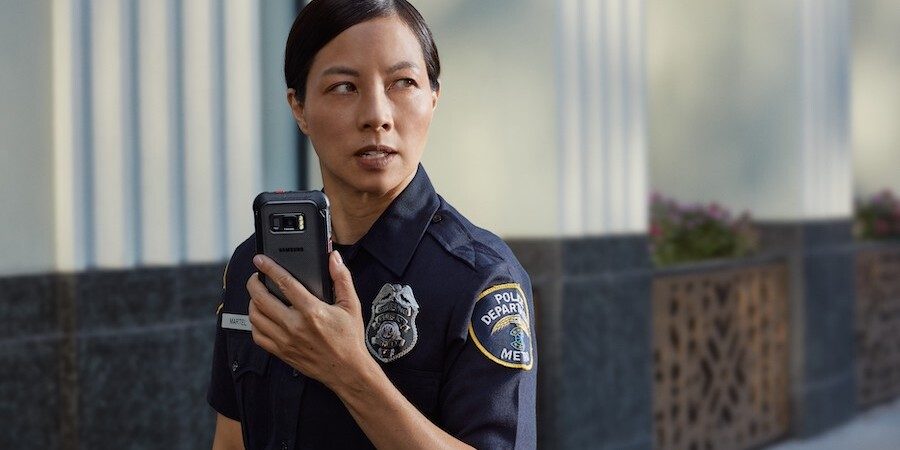Look inside a marked police vehicle and you’ll almost always find a computer, bolted to the dash beside the driver’s seat. Often described as mobile data terminals or MDTs, these ruggedized computers provide officers with access to a wide variety of information sources and capabilities, such as regional and national databases. In-vehicle computers also support other mission-critical functions, like computer-aided dispatch (CAD), control of video units and license plate reader systems.
This type of computing power used to be limited to those officers assigned to a desk, while those in the field were stuck making queries by radio. Now, mobile computers can empower today’s officers with situational awareness, including other units’ location and alerts to emerging situations. However, for most departments, that ready access to information effectively ends when the officer steps outside the vehicle. And the reality of policing is that the most effective officers are those who don’t stay in their air-conditioned mobile “offices.”
Your guide to mobilizing law enforcement
Plan and implement a mobile initiative at your agency with this practical road map. Download Now
An officer’s vehicle serves as an effective base for operations, so leaving the vehicle usually means stepping away from all but the most basic information sources. As a result, officers must rely on their radios, and interaction with dispatch means even the most basic query now requires two officers to be involved. Progressive law enforcement agencies are quickly finding that properly equipped and secured smartphones can replicate and extend the functionality of in-vehicle computers for officers on foot. But it is surprising how many agencies have yet to add smartphones to their standard technology kit for all field-based officers.
Adding smartphones to your technology road map
Smartphones not only provide ready access to information, they also enable features that, for the most part, go well beyond the capabilities of in-vehicle computers. Some capabilities are made possible with an off-the-shelf consumer smartphones, while others require specialized applications or added accessories. Here’s a partial list of what’s already available today:
- High resolution camera for capturing images and videos of evidence
- On-scene information collection, recording and note taking
- Timely, mission-critical data retrieval
- Mobile CAD (extends the smartphone into a fully functional CAD-addressable device)
- Access to records management systems
- Query of criminal justice databases, if compliant with Criminal Justice Information Services (CJIS) policy
- Voice assistance
- Improved situational awareness through officer-specific geolocation
- Electronic citations
- Basic language translation
- Access to department policies and training videos
Though many agencies have some smartphones deployed, the devices often go to administrators for their base-level functions, like calling, texting and email. That’s changing as departments realize the significant return on investment (ROI) from issuing smartphones to field officers. Not only do smartphones extend an officer’s resources beyond their patrol vehicle, the practical utility is enormous. In 2021, they should be considered essential technology to be issued to every law enforcement officer.
New rugged, push-to-talk ready smartphones can supplement radios, allowing a single device to support mission-critical voice as well as access to rich multimedia data. And departments that use mobile devices to access criminal justice databases will find it much easier to achieve CJIS compliance with agency-issued smartphones. In short, a BYOD approach is unideal.
Applications abound
Most law enforcement agencies also have some personnel who operate without a traditional vehicle, and therefore don’t have a platform to support an in-vehicle computer.
For law enforcement personnel who work by bike, foot patrol or motorcycle, in plainclothes details, school resource positions or marine units, smartphones can empower them with real-time mission-critical data, increasing their situational awareness and overall productivity — wherever their operations take them.
What’s more, with technology such as Samsung DeX — which offers a rich desktop experience right from a mobile device — officers can bring any work and recorded data from the field directly into the office, without interrupting their workflow. For example, if an officer was taking notes in the field on their Galaxy S20 or Note 20, when they return to the office, they can use DeX to connect to a large display and a full-size keyboard for a desktop experience with complete access to all their productivity apps. And because the information stored on these smartphones protected by Samsung Knox — which provides defense-grade security built right into the hardware — officers can be assured their data is always safe.
With DeX in vehicle, the smartphone can also replace the MDT, by pairing with a dashmounted screen and keyboard.
For any agency that embraces intelligence-led policing, smartphones are powerful tools to boost officer efficiency. Mobile devices can effectively augment existing law enforcement technology by providing added functionality and creating an efficient connected-officer capability.
Learn more about the advantages of going mobile in our free Ultimate Law Enforcement Agency Guide to Going Mobile. And discover how you can containerize public safety mobile apps for CJIS compliance with the help of Samsung Knox.









